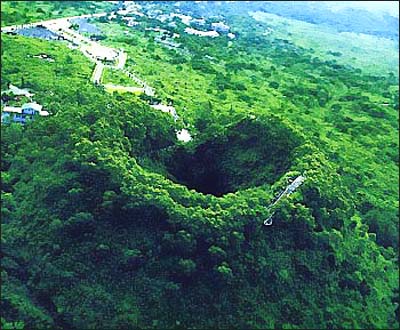| Home / International / International -- Cultural Sidelines | Tools: Save | Print | E-mail | Most Read |
| Global Recognition for Chinese Geoparks |
| Adjust font size: |
Six of China's national geoparks joined the Global Geopark Network on Monday at the second International Geoparks Conference in Belfast, Northern Ireland. The six geoparks are Mount Tai Geopark in Shandong Province; Wangwu-Daimei Moutains Geopark and Funiushan Geopark in Henan Province; Leiqiong Volcano Geopark in Guangdong and Hainan Provinces; Fangshan Geopark in Beijing Municipality and Hebei Province and Jingpo Lake Geopark in Heilongjiang Province. Six geoparks in other countries also gained entry including three from Spain and one each from Norway, Portugal and Brazil. Jiang Jianjun, director of the geological environment department under China's Ministry of Land and Resources, attended the conference as head of the Chinese delegation. Before the conference UNESCO awarded certificates to representatives from the previous group of global geoparks including four in China -- Yandangshan Geopark in Zhejiang Province; Keshiketeng Geopark in the Inner Mongolia Autonomous Region; Xingwen Geopark in Sichuan Province and Taining Geopark in Fujian Province. UNESCO announced the establishment of the Global Geopark Network in April 2004. Twenty-five National Geoparks (17 European and eight Chinese) were evaluated and became members of the first group of UNESCO Global Geoparks. China's first eight are Huangshan Geopark in Anhui Province; Lushan Geopark in Jiangxi Province; Yuntaishan and Songshan Geoparks in Henan Province; Shilin Stone Forest Geopark in Yunnan Province; Danxiashan Geopark in Guangdong Province; Zhangjiajie Sandstone Peak Forest Geopark in Hunan Province and Wudalianchi Geopark in Heilongjiang Province. According to UNESCO a geopark is a territory with outstanding geological interest as well as archaeological, ecological or cultural value where there are considerable local efforts being made to preserve and enhance the heritage.
Mount Tai Geopark
Wangwu-Daimei Moutains Geopark
Leiqiong Volcano Geopark
Fangshan Geopark
Jingpo Lake Geopark (China Daily September 20, 2006) |
| Tools: Save | Print | E-mail | Most Read |
 |
| Related Stories |





